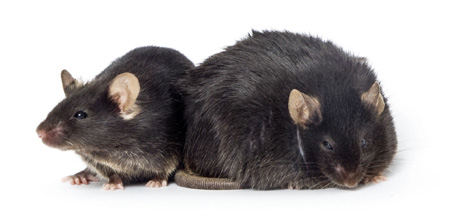Obesity is a serious problem, affecting some 1 billion people worldwide, according to the World Health Organization. A solution being explored by an NIH research team led by Dr. George Kunos is based on the link between obesity and the over-activity of the endocannabinoid system, a system that regulates appetite, lipogenesis and insulin resistance. Kunos and his team developed a drug that reduces obesity-associated cardiometabolic risks in mice by blocking the endocannabinoid system in peripheral tissues (Tam et al. 2010). Because the drug does not produce the negative side effects associated with previous endocannabinoid antagonists, it may mitigate several obesity-associated disease risks.
Endocannabinoids
Endocannabinoids are related to cannabinoids, the compounds thought to produce Cannabis' euphoric effects. They occur naturally in a variety of animals – including fish, reptiles, birds and mammals – and interact with the same CB1R and CB2R receptors that recognize the Cannabis’ cannabinoids and regulate a host of physiological functions. Although CB1Rs are highly expressed in the brain, they are also expressed at much lower levels in various peripheral tissues, including the liver, skeletal muscle, pancreas and fat.
Activating CB1Rs increases appetite, insulin resistance and hepatic lipogenesis. In fact, an overactive endocannabinoid system is a characteristic of obesity, and CB1R antagonists have been shown to reduce weight and the risk of cardiometabolic disease in obese rodents and humans. However, CB1R antagonists produced so far penetrate the blood-brain barrier and produce negative side effects, including anxiety, depression and suicidal tendencies. Because of such negative side effects, the FDA did not approve one such antagonist, rimonabant, and Europe removed it from the market and withdrew related compounds from preclinical trials (Tam et al. 2010).
AM6545: a brain-friendly alternative to rimonabant
Kunos and his team reasoned that CB1R antagonists whose activities are restricted to peripheral tissues may alleviate obesity-associated disease risks without producing the negative side effects of brain-penetrant CB1R antagonists. Thus, they developed a modified version of rimonabant called AM6545. In a series of experiments involving C57BL/6J mice (B6J, 000664), Cb1r-deficient (Cb1r-/-), Mdr1a/b-/-, and Mdr1a/b-/-abcg2-/- mice (all on a B6J background), they demonstrated that AM6545 does not penetrate the blood-brain barrier, interacts only on CB1Rs in peripheral tissues, and causes virtually none of the central nervous system-mediated neuropsychiatric side effects associated with rimonabant.
AM6545 reverses obesity phenotypes in mice
Kunos' team analyzed the effects of AM6545 in three different mouse models of obesity:
DIO Mice. AM6545 is as or nearly as effective as rimonabant in either improving or normalizing the metabolic profiles of diet-induced obese (DIO) B6J males. Both compounds reduce CB1R expression, increase the expression of lipolytic but decrease the expression of lipogenic enzymes; reduce total caloric intake and body weight; reverse hepatic steatosis and liver damage; improve blood glucose, insulin, serum ALT, hepatic triglyceride, leptin and adipokine levels; normalize glucose tolerance; and improve insulin sensitivity in these mice.

Ob/ob mice. Although to different degrees, AM6545 and rimonabant both ameliorate the metabolic profiles of leptin-deficient B6.V-Lepob/J ("ob/ob" 000632) mice. Both substances significantly improve glucose tolerance and insulin resistance and reduce plasma glucose and insulin. Although both short- (seven-day) and long-term (28-day) treatments with AM6545 reduce liver damage and hepatic triglycerides, only long-term treatments with rimonabant reduce hepatic triglycerides. Long-term treatments with either substance reduce LDL cholesterol, but only long-term treatments with AM6545 increase HDL cholesterol. Only long-term treatments with rimonabant significantly reduce body weight and adiposity, indicating that AM6545 improves or normalizes metabolic phenotypes independent of weight.
Liver-specific CB1R-expressing mice Kunos and his team generated transgenic mice that express CB1R only in the liver. When fed a high-fat diet, these mice exhibit significant increases in hepatic triglycerides, severe glucose intolerance, and severe insulin resistance. Short-term treatment with AM6545 completely reverses these phenotypes.

In summary, Kunos and his team demonstrated that AM6545 is a peripheral tissue-specific CB1R antagonist, does not penetrate the blood-brain barrier, and does not produce the adverse side-effects of brain-penetrant CB1R antagonists such as rimonabant. In mice with either genetic or diet-induced obesity, it improves glucose homeostasis, reverses liver steatosis, and improves or normalizes plasma lipid profiles independently of weight. Therefore, targeting peripheral CB1R may be a viable therapy for alleviating cardiometabolic risk in obese patients.
Reference
Tam J, Vemuri VK, Liu J, Batkai S, Mukhopadhyay B, Godlewski G, Osei-Hyiaman D, Ohnuma S, Ambudkar SV, Pickel J, Makriyannis A, Kunos G. 2010. Peripheral CB1 cannabinoid receptor blockade improves cardiometabolic risk in mouse models of obesity. J Clin Invest 120:2953-66.